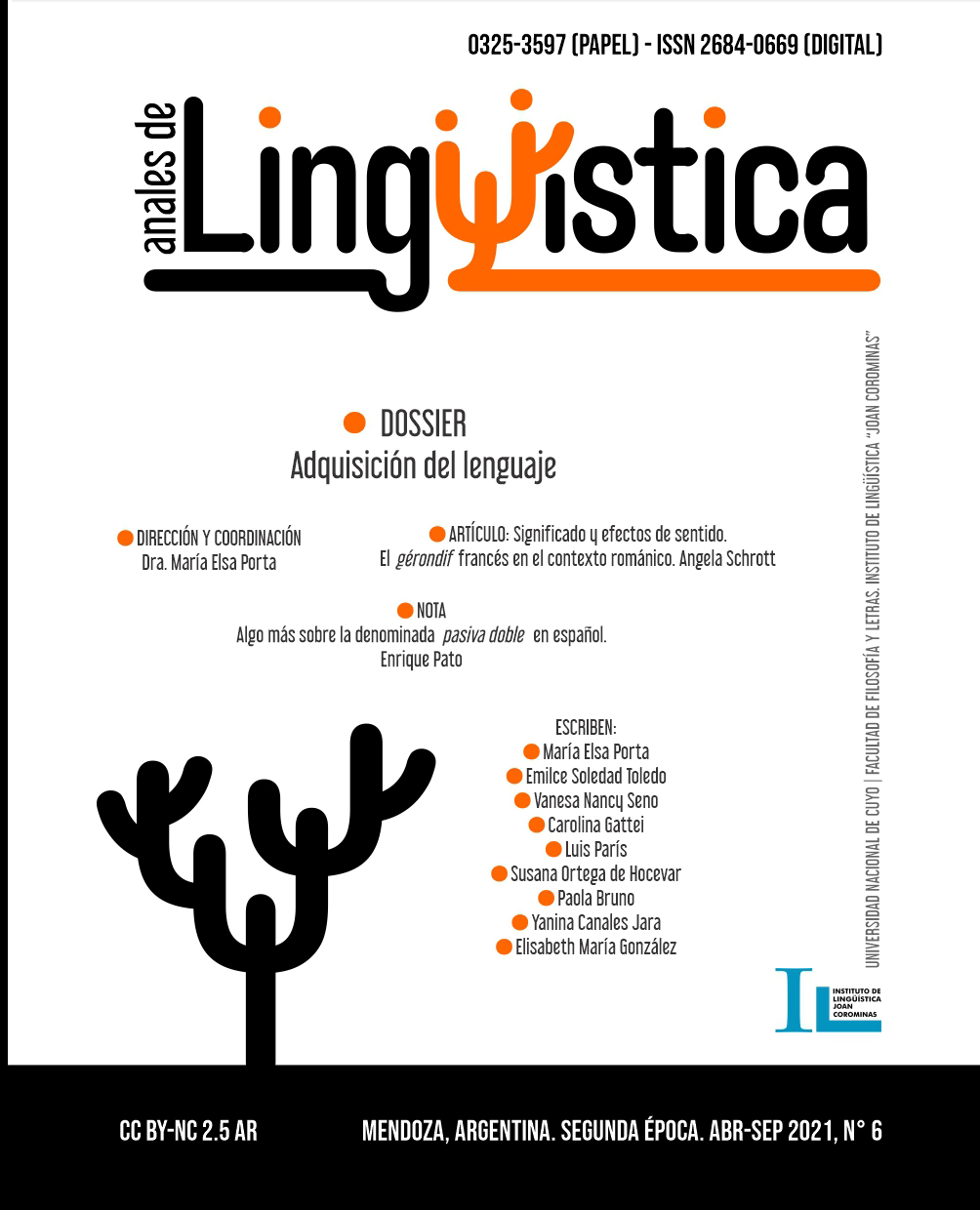Algo más sobre la denominada pasiva doble en español
Palabras clave:
Español, Gramática, Sintaxis, Pasiva doble, PredicadosResumen
Esta breve nota sobre la gramática de la pasiva doble en español (fue empezada a ser construida) resume, en un primer momento, los dos trabajos previos publicados sobre esta construcción: el de Bosque y Gallego (2011) y el de Krivochen y Bravo (2019), para después aportar algunos datos nuevos a la descripción de dicha construcción. En concreto, gracias a los ejemplos de corpus, se revisan los predicados auxiliares, los participios auxiliados y las preposiciones seleccionadas en la pasiva doble. Asimismo, se ofrecen otras consideraciones menores en torno a la concordancia del participio, la intercalación de adverbios y su documentación en otras lenguas romances y no romances. Se concluye con la idea de que el fenómeno de la pasiva doble puede ser entendido como un caso más de formación predicativa compleja.
Citas
Asociación de Academias de la Lengua Española (2010). Diccionario de americanismos. Lima: Santillana.
Bosque, I. y Gallego, Á. (2011). «Spanish Double Passives and Related Structures».
Linguística. Revista de Estudos Linguísticos da Universidade do Porto, 6(1), 9-50.
Chomsky, N. (2000). «Minimalist inquiries: The framework». En: R. Martin et al. (eds.), Step by step. Essays on minimalist syntax in honor of Howard Lasnik (pp. 89-155). Cambridge, MA: MIT Press.
Chomsky, N. (2001). «Derivation by phase». En: M. Kenstowicz (ed.), Ken Hale: A life in language (pp. 1-52). Cambridge, MA: MIT Press.
Cinque, G. (2003). «The Interaction of Passive, Causative, and “Restructuring” in Romance». En: Ch. Tortora (dir.), The Syntax of Italian Dialects (pp. 50-66). Oxford/ New York: Oxford University Press.
Davies, M. Corpus del español: Web/ Dialectos. Provo, UT: Brigham Young University. http://www.corpusdelespanol.org
Fábregas, A. (2019). «Periphrases in Spanish: properties, diagnostics and research questions». Borealis: An International Journal of Hispanic Linguistics, 8(2), 1-82.
Hobæk Haff, M. y Lødrup, H. (2016). «Où en est le « passif long » en Français ?». Syntaxe et sémantique, 17, 153-173.
Krivochen, D. G. y Bravo, A. (2019). «Pasivas adelantadas, dobles pasivas y auxiliares de pasiva léxicos». Revista de la Sociedad Española de Lingüística, 49, 73-100.
Real Academia Española. Banco de datos (CORDE). Corpus diacrónico del español. Madrid: RAE. http://www.rae.es
Real Academia Española. Banco de datos (CREA). Corpus de referencia del español actual. Madrid: RAE. http://www.rae.es
Real Academia Española. Corpus del español del siglo XXI (CORPES XXI), [versión 0.9]. Madrid: RAE. http://www.rae.es
Real Academia Española y Asociación de Academias de la Lengua Española (2009).
Nueva gramática de la lengua española. Madrid: Espasa.
Wurmbrand, S. (2004). «Two Types of Restructuring – Lexical vs. Functional». Lingua, 114(8), 991-1014.
Wurmbrand, S. (2016). «Complex Predicate Formation via Voice Incorporation». En: Nash, L. y Samvelian, P. (eds.), Approaches to Complex Predicates (pp. 248-290). Leiden: Brill.
Descargas
Publicado
Cómo citar
Número
Sección
Licencia
Derechos de autor 2021 Anales de Lingüística
Esta obra está bajo una Licencia Creative Commons Atribución 2.5 Argentina.
Los/as autores/as que publican en esta revista están de acuerdo con los siguientes términos:
1. Los/as autores conservan los derechos de autor y garantizan a la revista el derecho de ser la primera publicación del trabajo bajo una licecncia Creative Commons Atribución 2.5 Argentina (CC BY 2.5 AR) . Por esto pueden compartir el trabajo con la referencia explícita de la publicación original en esta revista.
2. Anales de lingüística permite y anima a los autores a difundir la publicación realizada electrónicamente, a través de su enlace y/o de la versión postprint del archivo descargado de forma independiente.
3. Usted es libre de:
Compartir — copiar y redistribuir el material en cualquier medio o formato
Adaptar — remezclar, transformar y construir a partir del material para cualquier propósito, incluso comercialmente.























